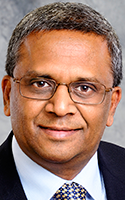By Ernst Lamothe Jr.
 A small tweak to the back and spine can cause pain and affect range of motion for the entire body. Sometimes it occurs from awkwardly picking up an item, while other times you can simply wake up in pain.
A small tweak to the back and spine can cause pain and affect range of motion for the entire body. Sometimes it occurs from awkwardly picking up an item, while other times you can simply wake up in pain.
David Moorthi, an interventional spine care specialist at St. Joseph’s Physicians Spine Care in Syracuse, understands the need for preventive care for the back and spine. However once the problem begins, he intervenes in acute spine pain through development and coordination of treatment plans that seek to prevent unnecessary surgeries.
“Eighty-five percent of back and neck pain often goes away by itself,” said Moorthi, who is certified by the American Board of Physical Medicine and Rehabilitation. “It may be painful initially but there are many things the public doesn’t know that could help with conservative treatment of the pain.” Moorthi offers five preventive tips to surgery for spine, back and neck pain.
1. Visit your primary doctor
A primary care doctor has the history of when your pain began and can offer you a solid, clinical evaluation in most cases. They will be able to listen, touch, feel and make decisions based on the examination. In addition, if you have questions about musculoskeletal conditions, you may want to undergo a digital health assessment to know which causes the pain.
“Your doctor can often assess where the pain is coming from and offer a treatment plan,” said Moorthi.
Also, because they know your history, your primary care physician can talk to you about lifestyle choices such as exercise and nutrition that will be beneficial in creating a solid frame.
“If you are overweight and the muscles around your body are flabby that doesn’t support the spine as well as it could,” said Moorthi.
2. Treat it conservatively
There was always a debate between physicians if cooling or heating back pain works better. Moorthi prefers the latter.
“Warm packs tend to work better for acute back and neck pain,” he said. “It also helps to take some anti-inflammatory medication to make it better.”
He also suggests spinal decompression and massages as a possible medium for relief. Because muscles tend to stiffen up, having a massage therapist work the body can often make them more relaxed. You can also go to a Back Pain Management Facility to treat it.
3. Stretching
Stretching may take a back seat to your exercise routine, but it shouldn’t. Stretching may help you:
• Improve your joint range of motion
• Improve your athletic performance
• Decrease your risk of injury
Studies about the benefits of stretching have had mixed results. Some show that stretching helps. Other studies show that stretching before or after exercise has little to no benefit.
“One of the first things I tell patients is that they should stretch every day,” said Moorthi. “Stretching your neck, back, pelvis, legs and abdominal muscles can strengthen your body. When the muscles are relaxed, they tend to work more efficiently.”
Something simple like taking a moment in your office between your eight-hour shifts and just standing up and stretching your arms can make a world of difference.
“You want to stay mobile and active throughout the day,” he added. “It is very easy to stiffen up and get yourself in more pain.”
4. Avoid twisting and turning
We have all heard the advice about bending with your knees when lifting heavy objects. However, there is something else that we do that might cause more damage than not bending at the knee.
“People don’t realize that when they pick up heavy weight they often twist and turn their whole bodies. That can cause a lot of strain on your back,” added Moorthi. “Because the pelvic joint does most of the work on the lower body, when you twist while carrying something heavy it can cause an awkward motion for the body which results in possible injury.”
5. Chiropractic
Chiropractic is a health care profession dedicated to the non-surgical treatment of disorders of the nervous system and/or musculoskeletal system. Generally, chiropractors from a good clinic similar to Chiropractor Albany, GA treatment center maintain a unique focus on spinal manipulation and treatment of surrounding structures.
Many studies have concluded that manual therapies like decompression therapy commonly used by chiropractors are generally effective for the treatment of lower back pain as well as for lumbar herniated disc treatment, neck pain, among other conditions.
“A lot of time healthcare professionals demonize chiropractic care. But I do believe that it can be useful,” said Moorthi. “I have seen patients get adjusted by a chiropractor for lower back pain and they all of a sudden hear a pop that loosens something up and they feel better. Modern medicine doesn’t have all the answers so I believe you have to look at all conditions from every angle.”
